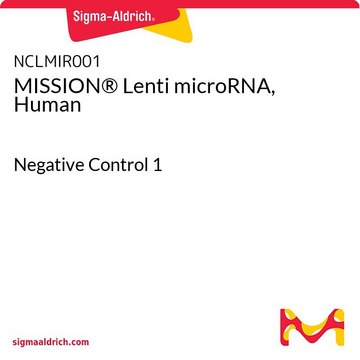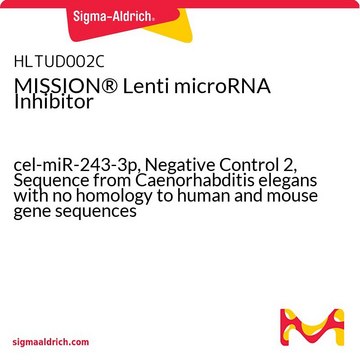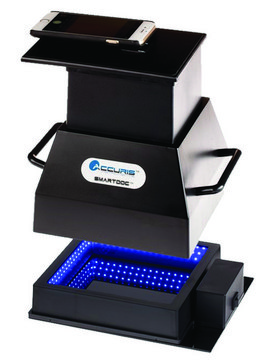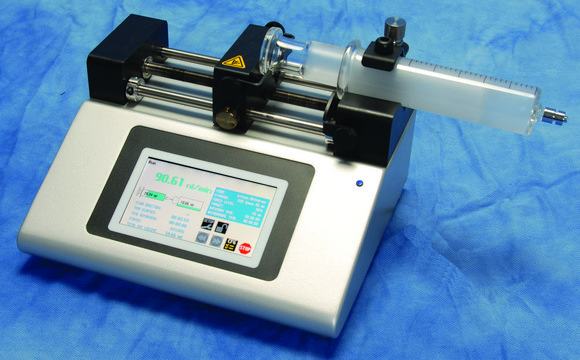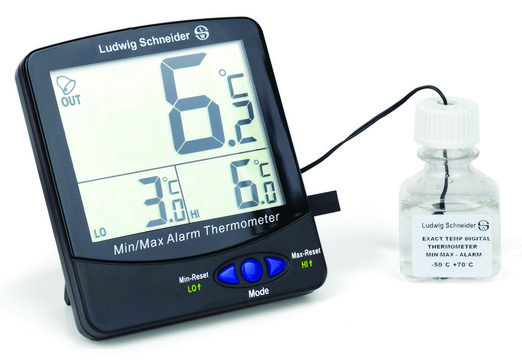HLTUD001C
MISSION® Lenti microRNA Inhibitor
ath-miR416, Negative Control 1, Sequence from Arabidopsis thaliana with no homology to human and mouse gene sequences
Synonym(s):
Tough Decoy, TuD
Sign Into View Organizational & Contract Pricing
All Photos(1)
About This Item
UNSPSC Code:
41106609
NACRES:
NA.51
Recommended Products
Quality Level
product line
MISSION®
form
liquid
concentration
≥1x106 VP/ml (via p24 assay)
mature sequence
GGUUCGUACGUACACUGUUCA
Sanger mature/minor accession no.
Sanger microRNA accession no.
shipped in
dry ice
storage temp.
−70°C
Looking for similar products? Visit Product Comparison Guide
General description
Individual lenti microRNA inhibitors are designed using a proprietary algorithm, which is based on the work of Haraguchi, T, et al. and in collaboration with Dr. Hideo Iba, University of Tokyo. This algorithm utilizes the tough decoy (TuD) design. miRNA are known to regulate gene expression in a variety of manners, including translational repression, mRNA cleavage and deadenylation. The lentiviral microRNA Inhibitors are cloned into the TRC2-pLKO-puro vector. Co-transfection of this vector into the appropriate cell line with compatible packaging plasmids produces viral particles that can be used to transduce mammalian cells. Additionally, the Woodchuck Hepatitis Post-Transcriptional Regulatory Element2 (WPRE) is included, allowing for enhanced expression of transgenes delivered by lentiviral vectors. This lentiviral vector also carries a puromycin resistance gene for selection of cells.
- Allows for potent inhibition of the desired miRNA
- Lentiviral delivery format allows for efficient delivery of the inhibitor into a wide variety of cell types
- Enables long-term inhibition without repeat transfection
Other Notes
Based on miRBase V19 Mature ID
Legal Information
MISSION is a registered trademark of Merck KGaA, Darmstadt, Germany
Storage Class Code
12 - Non Combustible Liquids
WGK
WGK 3
Flash Point(F)
Not applicable
Flash Point(C)
Not applicable
Regulatory Information
新产品
Choose from one of the most recent versions:
Certificates of Analysis (COA)
Lot/Batch Number
Don't see the Right Version?
If you require a particular version, you can look up a specific certificate by the Lot or Batch number.
Already Own This Product?
Find documentation for the products that you have recently purchased in the Document Library.
Hujun Cui et al.
Digestive diseases and sciences, 62(8), 1995-2003 (2017-04-24)
Esophageal squamous carcinoma (ESC) is one of the most fatal malignancies worldwide with increasing occurrences yet poor outcome. MicroRNAs were reported to play roles in ESC. We aimed to understand how miRNAs affect the radiotherapy resistance of ESC. MicroRNA assays
Davide Marangon et al.
Glia, 68(10), 2001-2014 (2020-03-13)
In the last decade, microRNAs have been increasingly recognized as key modulators of glial development. Recently, we identified miR-125a-3p as a new player in oligodendrocyte physiology, regulating in vitro differentiation of oligodendrocyte precursor cells (OPCs). Here, we show that miR-125a-3p
Minfei Jin et al.
Stem cell research & therapy, 7(1), 167-167 (2016-11-20)
Pelvic floor dysfunction (PFD) is a condition affecting many women worldwide, with symptoms including stress urinary incontinence (SUI) and pelvic organ prolapse (POP). We have previously demonstrated stable elastin-expressing bone marrow-derived mesenchymal stem cells (BMSCs) attenuated PFD in rats, and
Jaira F de Vasconcellos et al.
Journal of translational medicine, 15(1), 169-169 (2017-08-05)
In humans, the heterochronic cascade composed of the RNA-binding protein LIN28 and its major target, the let-7 family of microRNAs (miRNAs), is highly regulated during human erythroid ontogeny. Additionally, down-regulation of the let-7 miRNAs in cultured adult CD34(+) cells or
Hui Dong et al.
Experimental and therapeutic medicine, 21(3), 212-212 (2021-01-28)
High mobility group protein B1 (HMGB1) is a nuclear protein that has been reported to contribute to tumor growth in humans. The present study identified a microRNA (miR/miRNA) that targets the 3' untranslated region (3'UTR) of the HMGB1 gene and
Our team of scientists has experience in all areas of research including Life Science, Material Science, Chemical Synthesis, Chromatography, Analytical and many others.
Contact Technical Service